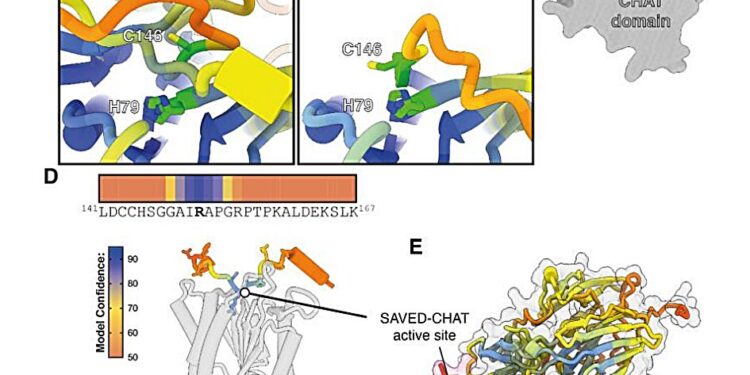Structural analysis of PCaspase. (A) Top: Full-length PCaspase AlphaFold2 model. Below: zoom in on the catalytic dyad. (B) Top: Processed PCaspase AlphaFold2 model. Below: Zoom in on the catalytic dyad, which is now in a catalytically competent conformation. (C) AlphaFold2 multimeric co-folding of the CHAT domain of SAVED-CHAT with PCaspase autoinhibitory loop. (D) AF2 model of the PCaspase fragment bound to the CHAT domain of SAVED-CHAT. (E) AF2 model of the complete PCaspase domain and SAVED-CHAT CHAT. (F) Interactions between PCaspase R153 and the CHAT domain of the AF2 model in panels C and D. Credit: Science (2024). DOI: 10.1126/science.adk0378
Researchers from Wageningen have discovered a molecular self-destruct mechanism in a bacteria living on algae. Through this mechanism, bacteria sacrifice themselves when infected, thereby protecting their siblings from infection. By reprogramming this mechanism, researchers aim to use it in diagnostic (self)tests. The study is published in Science.
The self-destruct mechanism belongs to the bacterial immune system known as CRISPR-Cas, which researchers have studied widely for more than a decade. This defense system is present in about half of all bacteria and exists in various forms.
The newly discovered system triggers self-destruction when it detects an invading virus. Normally, such a virus would exploit the bacteria as a production factory to replicate itself. By sacrificing itself, the bacteria prevents an epidemic. “We always suspected that bacteria could sacrifice themselves using this system, but now we have proof,” explains Raymond Staals, associate professor of microbiology.
Fall apart into pieces
When a virus injects its genetic material into a bacteria, the immune system sounds the alarm. “This particular immune system of the oceanic bacteria distinguishes the DNA or RNA of a virus from its own genetic material,” explains Staals.
When Staals first studied this mechanism 13 years ago, he discovered that this CRISPR-Cas system cuts RNA. This seemed illogical since viruses continually produce new RNA. “What an inefficient system, I thought at the time,” Staals says. “That never sat well with me.”
It now turns out that RNA scissors are just one small step in the immune system as a whole. Ultimately, the immune system activates enzymes that uncontrollably destroy essential biomolecules: RNA, DNA and proteins, killing the bacteria from the inside out.
Checkpoints
“What makes this whole system so fascinating is the built-in checkpoints,” says Staals. “This prevents the bacteria from ‘accidentally’ pressing that self-destruct button.” The trick lies in a molecular domino effect with feedback loops that regulate the process. The dominoes begin to fall when the bacteria detects an invader. It then produces signaling molecules that activate other proteins. These proteins, in turn, activate the “great destroyer”.
During this process, the cell also continually breaks down the molecules it produces, disrupting the domino effect. The self-destruction process only takes place if the bacteria continuously recognizes the foreign RNA or DNA. This prevents the bacteria from self-destructing due to a false alarm. “It’s a strange chain reaction, similar to programmed cell death (apoptosis) in humans, but simpler,” says Staals.
The precision of this newly discovered CRISPR-Cas system makes it ideal for developing disease diagnostic tests. In collaboration with Scope Biosciences, a spin-off company from TNO and Staals, Wageningen researchers will work on developing diagnostic tests over the coming years.
They aim to create tests that can simultaneously detect multiple targets, such as diseases, and are easy to interpret. A Ph.D. The candidate will take charge of this project starting in March. Staals hopes to have the first diagnostic test by 2025.
More information:
Jurre A. Steens et al, CRISPR-Cas type III-B cascade of proteolytic cleavages, Science (2024). DOI: 10.1126/science.adk0378
Provided by Wageningen University
Quote: Newly discovered bacterial defense system works like a self-destruct button (February 16, 2024) retrieved February 16, 2024 from
This document is subject to copyright. Apart from fair use for private study or research purposes, no part may be reproduced without written permission. The content is provided for information only.



